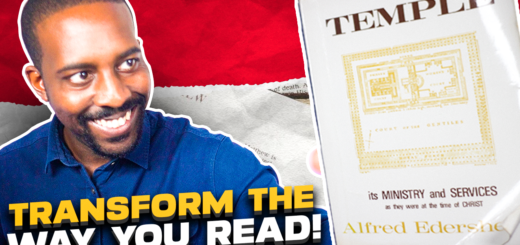NOPE! Hebrews 1:5 Doesn’t Teach Jesus Sinned — Here’s Why
Sometimes, a surface reading of Scripture can lead to big misunderstandings — and one of those misunderstandings is the idea that Hebrews 1:5 implies Jesus sinned.
This post is meant to clear that up and help you learn how to interpret Scripture in context, especially when the New Testament quotes the Old.
This isn’t just about defending a doctrine — it’s about growing in how we read and apply the Bible, and ultimately, in how we see Jesus.
 The Controversial Verse in Hebrews
The Controversial Verse in Hebrews
Let’s start by looking at the verse in question:
“For to which of the angels did He ever say: ‘You are My Son, today I have begotten You’? And again: ‘I will be to Him a Father, and He shall be to Me a Son’?” – Hebrews 1:5
This is part of the opening argument in the book of Hebrews, where the author is showing that Jesus is greater than the angels, superior in every way, and uniquely the Son of God.
To support this, the writer references Old Testament passages — one of which is 2 Samuel 7:14.
Let’s go to that Old Testament verse:
“I will be his Father, and he shall be My son. If he commits iniquity, I will chasten him with the rod of men and with the blows of the sons of men.” – 2 Samuel 7:14
Here’s the issue some people raise: Hebrews applies a verse to Jesus that mentions committing iniquity and being chastened — so does that mean Jesus sinned?
At first glance, the question seems fair. But it overlooks the broader context of Biblical prophecy and how the New Testament uses Old Testament texts.
In 2 Samuel 7, God speaks to King David through the prophet Nathan.
While David wants to build a temple, God instead makes a covenant with him — promising a dynasty, a kingdom, and a son who will build the temple and whose throne will stand forever.
That son is Solomon, and the part about committing iniquity clearly applies to him. Solomon did fall into idolatry and disobedience later in his reign:
“So the LORD became angry with Solomon, because his heart had turned from the LORD God of Israel… Therefore the LORD said to Solomon, ‘I will surely tear the kingdom away from you.’” – 1 Kings 11:9,11
Yet God’s mercy did not depart from Solomon entirely, just as He promised David. This is the “direct” or initial fulfillment of 2 Samuel 7.
 Jesus: The Greater Son, the Perfect Fulfillment
Jesus: The Greater Son, the Perfect Fulfillment
Biblical prophecy often unfolds in layers. Solomon initially fulfills the promise, but Jesus fully realizes it as the Son whose kingdom is eternal.
“And He will reign over the house of Jacob forever, and of His kingdom there will be no end.” – Luke 1:33
This is where typology comes into play. In Biblical interpretation, a type is a person or event that foreshadows a greater reality.
Jesus, unlike Solomon, never sinned:
“For we do not have a High Priest who cannot sympathize with our weaknesses, but was in all points tempted as we are, yet without sin.” – Hebrews 4:15
So when Hebrews 1:5 references 2 Samuel 7:14, it’s not saying Jesus might sin. Instead, it’s declaring Him as the fulfillment of the royal Son promised to David — the one who perfectly embodies everything Solomon could not.
Jesus was chastised, but not for His own iniquity. He bore the punishment that we deserved:
“But He was wounded for our transgressions, He was bruised for our iniquities; the chastisement for our peace was upon Him, and by His stripes we are healed.” – Isaiah 53:5
What a powerful reversal: the innocent Son takes the place of the guilty. This is why understanding typology is so important — without it, we risk reducing the profound to the problematic.
 How the First-Century Jews Read the Bible
How the First-Century Jews Read the Bible
The early Jewish audience of the book of Hebrews would have immediately understood this method of interpretation.
Rabbinic tradition held to four levels of Scriptural interpretation, sometimes known by the acronym PaRDeS:
- Peshat (Literal) – The plain meaning.
- Remez (Hint) – Implied or hinted meanings.
- Derash (Allegorical or Typological) – Moral or symbolic applications.
- Sod (Mystical or Hidden) – Deep spiritual truths.
When the author of Hebrews uses 2 Samuel 7, it’s a Derash — a typological use of Scripture that highlights the deeper, messianic truth.
This was not a blunder. It was a masterful interpretation grounded in Jewish tradition and the guidance of the Holy Spirit.
 No, Jesus Did Not Sin
No, Jesus Did Not Sin
This discussion isn’t just about theology — it’s about how we read our Bibles. Do we stop at the surface? Or do we slow down, seek the context, and look for the bigger picture?
When we read with understanding, we see that Jesus doesn’t just appear in the New Testament — He threads through the Old, fulfills prophecies, embodies types, and completes God’s promises.
Hebrews 1:5, when rightly understood, doesn’t suggest Jesus sinned — it proclaims Him as the true, eternal Son of God, greater than angels and kings.
By recognizing the layered fulfillment of prophecy, we see that Scripture consistently upholds the sinlessness of Christ and His role as the ultimate fulfillment of God’s promises.
If this topic sparked your interest, you might also enjoy this related article that explores another often misunderstood passage.
This reminds us that Scripture is deeply interconnected — and every part points us back to Jesus.
WATCH THE VIDEO
























Recent Comments